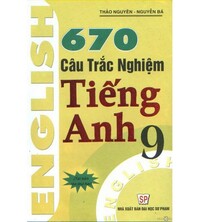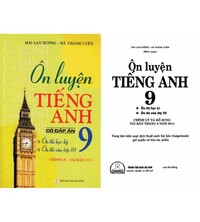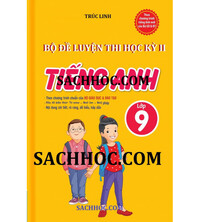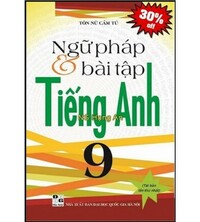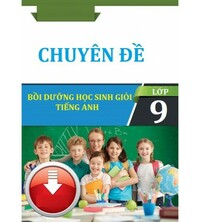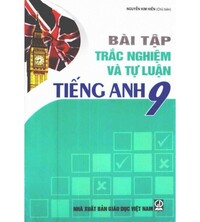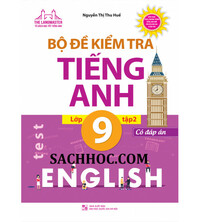A Closer Look 1 Unit 1 trang 8 SGK tiếng Anh 9 mới
3. What are some places of interest in your area? Complete the word web. One word can belong to more than one category. Địa điểm tham qua ở chỗ bạn là gì? Hoàn thành sơ đồ sau. Một từ có thể thuộc nhiều hơn 1 mục
A CLOSER LOOK 1
Bài 1
Task 1. Write the verbs in the box under the pictures. One of them should be used twice.
(Điền các động từ sau vào trong bảng. Một trong số chúng phải được dùng 2 lần.)
|
carve |
cast |
weave |
|
embroider |
knit |
mould |

Lời giải chi tiết:
A. cast (đúc)
B. carve (chạm khắc)
C. embroider (thêu)
D. weave (đan)
E. mould (khuôn)
F. weave (dệt)
G. knit (đan)
Bài 2
Task 2. a. Match the verbs in column A with the groups of nouns in column B.
(Nối các động từ ở cột A với danh từ ở cột B.)
|
A |
B |
|
1. carve |
a. handkerchiefs, tablecloths, pictures |
|
2. cast |
b. stone, wood, eggshells |
|
3. weave |
c. clay, cheese, chocolate |
|
4. embroider |
d. bronze, gold, iron |
|
5. knit |
e. baskets, carpets, silk, cloth |
|
6. mould |
f. sweaters, toys, hats |
b. Now write the corect verb forms for these verbs.
(Viết lại dạng đúng của những động từ sau)
|
Infinitive |
Past tense |
Past participle |
|
1. to carve |
I carved it. |
It was carved. |
|
2. to cast |
I _________ it. |
It was __________. |
|
3. to weave |
I _________ it. |
It was __________. |
|
4. to embroider |
I _________ it. |
It was __________. |
|
5. to knit |
I _________ it. |
It was __________. |
|
6. to mould |
I _________ it. |
It was __________. |
Lời giải chi tiết:
a)
1. b
(khắc chạm - đá, gỗ, vỏ trứng)
2. d
(đúc - đồng, vàng, sắt)
3. e
(đan, dệt - rổ, thảm, lụa, vải)
4. a
(thêu - khăn tay, khăn trải bàn, tranh)
5. f
(đan - áo len, đồ chơi, mũ)
6. c
(đúc khuôn - đất sét, phô mai, sô cô la)
b)
|
Infinitive |
Past tense |
Past participle |
|
1. to carve |
I carved it. |
It was carved. |
|
2. to cast |
I cast it. |
It was cast. |
|
3. to weave |
I wove it. |
It was woven. |
|
4. to embroider |
I embroidered it. |
It was embroidered. |
|
5. to knit |
I knitted it. |
It was knitted. |
|
6. to mould |
I moulded it. |
It was moulded. |
Tạm dịch:
|
Động từ nguyên thể |
Quá khứ đơn |
Quá khứ phân từ |
|
1. khắc |
Tôi đã khắc nó. |
Nó đã được khắc. |
|
2. đúc |
Tôi đã đúc nó. |
Nó đã được đúc. |
|
3. dệt |
Tôi đã dệt nó. |
Nó đã được dệt. |
|
4. thêu |
Tôi đã thêu nó. |
Nó đã được thêu. |
|
5. đan |
Tôi đã đan nó. |
Nó đã được đan. |
|
6. đổ khuôn |
Tôi đã đổ khuôn nó. |
Nó được đổ khuôn. |
Bài 3
Task 3. What are some places of interest in your area? Complete the word web. One word can belong to more than one category.
(Địa điểm tham quan ở chỗ bạn là gì? Hoàn thành sơ đồ sau. Một từ có thể thuộc nhiều hơn 1 mục.)

Lời giải chi tiết:
- Entertaining: cinema, department store, restaurant, café, theatre, opera house, club, park, zoo...
(Giải trí: rạp chiếu phim, cửa hàng bách hóa, nhà hàng, quán cà phê, rạp hát, nhà hát opera, câu lạc bộ, công viên, vườn thú ...)
- Cultural: opera house, museum, craft village, historical building, theatre, market, craft village...
(Văn hoá: nhà hát opera, bảo tàng, làng nghề, công trình lịch sử, sân khấu, chợ, làng nghề ...)
- Educational: library, museum, theatre...
(Giáo dục: thư viện, bảo tàng, rạp hát ...)
- Historical: building, temple, shopping district, market, beauty spot, craft village...
(Lịch sử: xây dựng, đền, khu mua sắm, chợ, cảnh đẹp, làng nghề ...)
Bài 4
Task 4. Complete the pasage by filling each blank with a suitable word from the box.
(Hoàn thành đoạn văn bằng cách điền vào chỗ trống từ thích hợp trong khung.)
|
attraction |
historical |
traditional |
|
handicrafts |
culture |
exercise |
Some people say that a place of interest is a place famous for its scenery or a well-known (1)_______ site. I don't think it has to be so limited. In my opinion, a place of interest is simply one that people like going to. In my town, the park is a(n) (2) _______ because many people love spending time there. Old people do (3) _______ and walk in the park. Children play games there while their parents sit and talk with each other. Another place of interest in my town is Hoa Binh market. It's a(n) (4) _______ market with a lot of things to see. I love to go there to buy food and clothes, and watch other people buying and selling. Foreign tourists also like this market because they can experience the (5) _______ of Vietnamese people, and buy woven cloth and other (6) _______ as souvenirs.
Lời giải chi tiết:
1. historical
Giải thích: Đằng sau là 1 danh từ ==>cần 1 tính từ để bổ nghĩa
historical site: di tích lịch sử
2. attraction
Giải thích: Đằng trước có mạo từ a ==> cần 1 danh từ số ít
3. exercise
Giải thích: do exercise (tập thể dục)
4. traditional
Giải thích: Đằng sau là 1 danh từ ==>cần 1 tính từ để bổ nghĩa
5. culture
Giải thích: Đằng trước có mạo từ "the"==> cần 1 danh từ
6. handicrafts
Giải thích: Đằng trước có từ "other"==> cần một danh từ số nhiều đếm được
Some people say that a place of interest is a place famous for its scenery or a well-known historical site. I don't think it has to be so limited. In my opinion, a place of interest is simply one that people like going to. In my town, the park is a(n) attraction because many people love spending time there. Old people do exercise and walk in the park. Children play games there while their parents sit and talk with each other. Another place of interest in my town is Hoa Binh market. It's a(n) traditional market with a lot of things to see. I love to go there to buy food and clothes, and watch other people buying and selling. Foreign tourists also like this market because they can experience the culture of Vietnamese people, and buy woven cloth and other handicrafts as souvenirs.
Tạm dịch:
Một số người cho rằng địa điểm tham quan du lịch phải là một nơi nổi tiếng với danh lam thắng cảnh hay một di tích lịch sử. Tôi không nghĩ khái niệm đó lại bị giới hạn như vậy. Theo tôi, một địa điểm tham quan đơn giản là một nơi mọi người thích đến.
Trong thị trấn của tôi, công viên là một điểm thu hút bởi vì nhiều người yêu thích dành thời gian ở đó. Người già tập thể dục và đi dạo trong công viên. Trẻ em chơi trò chơi ở đó trong khi bố mẹ ngồi và nói chuyện với nhau. Một nơi địa điểm khác được yêu thích ở thị trấn của tôi là chợ Hòa Bình. Đó là một khu chợ truyền thống với rất nhiều thứ để xem . Tôi thích đến đó để mua thức ăn và quần áo, và ngắm nhìn mọi người mua bán. Khách du lịch nước ngoài cũng thích khu chợ này vì họ có thể trải nghiệm văn hóa của người Việt Nam, mua vải dệt, quần áo và đồ thủ công mỹ nghệ khác làm quà lưu niệm.
Bài 5
Task 5. a. Listen to the speaker read the following sentences and answer the questions.
(Nghe người nói đọc những câu sau rồi trả lời câu hỏi.)
Sentence 1: The craft village lies on the river bank.
Sentence 2: This painting is embroidered.
Sentence 3: What is this region famous for?
Sentence 4: Drums aren't made in my village.
Sentence 5: A famous artisan carved this table beautifully.
1. Which words are louder and clearer than the others?
(Từ nào được đọc to và rõ hơn những từ khác?)
2. What kinds of words are they?
(Chúng là loại từ gì?)
3. Which words are not as loud and clear as the others?
(Những từ nào không được đọc to và rõ hơn những từ khác?)
4. What kinds of words are they?
(Chúng là loại từ gì?)
b. Now listen, check, and repeat.
(Bây giờ hãy nghe, kiểm tra và nhắc lại.)
Phương pháp giải:
Audio script:
1. The craft village lies on the river bank.
(Làng nghề thủ công nằm bên bờ sông.)
2. This painting is embroidered.
(Bức tranh này được thêu.)
3. What is this region famous for?
(Khu vực này nổi tiếng về cái gì?)
4. Drums aren't made in my village.
(Trống không được sản xuất ở làng của tôi.)
5. A famous artisan carved this table beautifully.
(Một nghệ nhân nổi tiếng chạm chắc cái bàn này thật đẹp.)
Lời giải chi tiết:
a)
1.
Sentence 1: craft, village, lies, river, bank
(Câu 1: nghề thủ công, làng, nằm, sông, bờ)
Sentence 2: painting, embroidered
(Câu 2: tranh vẽ, thêu)
Sentence 3: what, region, famous
(Câu 3: những gì, khu vực, nổi tiếng)
Sentence 4: drums, aren’t, made, village
(Câu 4: trống, không được làm, làng)
Sentence 5: famous, artisan, carved, table, beautifully
(Câu 5: nổi tiếng, nghệ nhân, chạm khắc, bảng, đẹp)
2. They are: nouns, verbs, adjectives, adverbs, wh-question words, and negative auxiliaries.
(Đó là danh từ, động từ, tính từ, phó từ, câu hỏi với từ để hỏi, và trợ động từ dạng phủ định )
3.
Sentence 1: the, on, the
(Câu 1: the, on, the)
Sentence 2: this, is
(Câu 2: this, is)
Sentence 3: is, this, for
(Câu 3: is, this, for)
Sentence 4: in, my
(Câu 4: in, my)
Sentence 5: a, this
(Câu 5: a, this)
4. They are: articles, prepositions, pronouns, and possessive adjectives.
(Chúng là: mạo từ, giới từ, đại từ, và tính từ sở hữu.)
Bài 6
Task 6. a. Underline the content words in the sentences. Practise reading the sentences aloud.
(Gạch dưới những từ nội dung trong các câu. Thực hành đọc to các câu.)
1. The Arts Museum is a popular place of interest in my city.
2. This cinema attracts lots of youngsters.
3. The artisans mould clay to make traditional pots.
4. Where do you like going at weekends?
5. We shouldn’t destroy historical buildings.
6 b. Now listen, check and repeat.
(Bây giờ nghe, kiểm tra và nhắc lại.)
Lời giải chi tiết:
1. The Arts Museum is a popular place of interest in my city.
(Bảo tàng Nghệ thuật là một nơi được yêu thích nổi tiếng của thành phố tôi.)
2. This cinema attracts lots of youngsters.
(Rạp chiếu phim này thu hút rất nhiều thanh thiếu niên.)
3. The artisans mould clay to make traditional pots.
(Các nghệ nhân đúc đất sét để làm chậu truyền thống.)
4. Where do you like going at weekends?
(Bạn thích đi đâu vào cuối tuần?)
5. We shouldn’t destroy historical buildings.
(Chúng ta không nên phá hủy các tòa nhà lịch sử.)
Từ vựng
1. ![]()
2. ![]()
3. ![]()
4. ![]()
5. ![]()
6. ![]()
7. ![]()
8. ![]()
9. ![]()
10. ![]()
11. ![]()
12. ![]()
13. ![]()
14. ![]()
15. ![]()
16. ![]()
17. ![]()
18. ![]()
19. ![]()
Search google: "từ khóa + timdapan.com" Ví dụ: "A Closer Look 1 Unit 1 trang 8 SGK tiếng Anh 9 mới timdapan.com"
